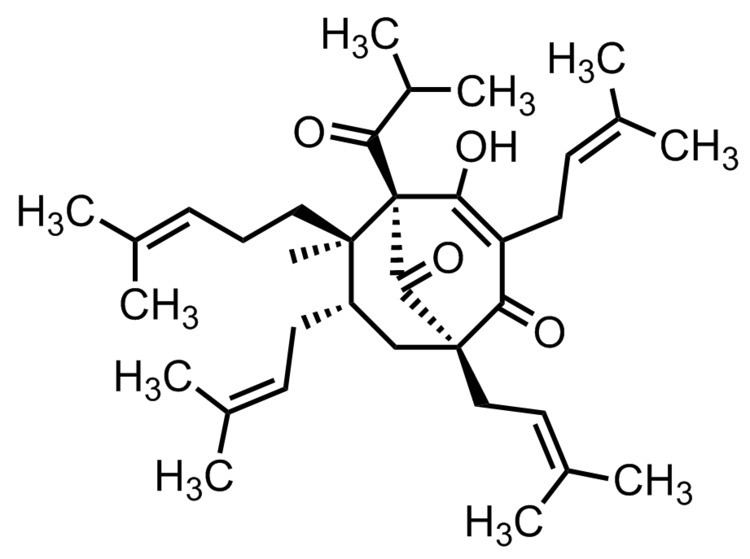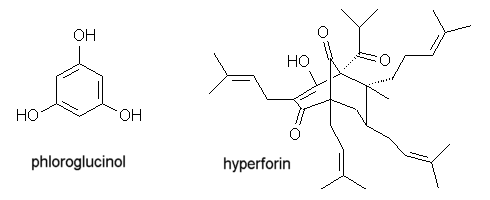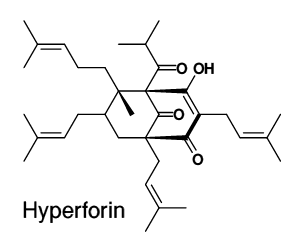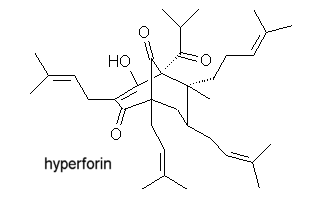Dependenceliability Nil ATC code none Formula C35H52O4 | Routes ofadministration Oral Biological half-life 9-19.64 hours Molar mass 536.78 g/mol | |
 | ||
Legal status US: OTCIn general: unscheduled Metabolism | ||
Hyperforin is a phytochemical produced by some of the members of the plant genus Hypericum, notably Hypericum perforatum (St John's wort). Hyperforin (along with adhyperforin) is believed to be one of the three chief active constituents of St. John's wort -the other two being hypericin (along with pseudohypericin) and several flavonoid constituents.
Contents

Occurrence

Hyperforin has only been found in significant amounts in Hypericum perforatum (St. John's wort) with other related species such as Hypericum calycinum (Greater St. John's wort or Aaron's beard) containing lower levels of the phytochemical. It is thought to be a reuptake inhibitor. It accumulates in oil glands, pistils, and fruits, probably as a plant defense against herbivory. Other Hypericum species contain low amounts of hyperforin.
Chemistry

Hyperforin is a prenylated phloroglucinol derivative. The structure of hyperforin was elucidated by a research group from the Shemyakin Institute of Bio-organic Chemistry (USSR Academy of Sciences in Moscow) and published in 1975. A total synthesis of the non-natural enantiomer of hyperforin was reported in 2010 and a total synthesis of the natural enantiomer was disclosed in 2012.
Hyperforin is unstable in the presence of light and oxygen.
Pharmacokinetics

Some pharmacokinetic data on hyperforin is available for an extract containing 5% hyperforin. Maximal plasma levels (Cmax) in human volunteers were reached 3.5h after administration of an extract containing 14.8 mg hyperforin. Biological half-life (t1/2) and mean residence time were 9h and 12h respectively with an estimated steady state plasma concentration of 100 ng/mL (approx. 180 nM) for 3 doses/d. Linear plasma concentrations were observed within a normal dosage range and no accumulation occurred.

In healthy male volunteers, 612 mg dry extract of St. John's wort produced hyperforin pharmacokinetics characterised by a half life of 19.64 hours. It appears to be metabolised, at least in part, by CYP3A and CYP2B into hydroxyl metabolites.
Biochemistry

Hyperforin is believed to be the primary active constituent responsible for the antidepressant and anxiolytic properties of the extracts of St. John's wort. It acts as a reuptake inhibitor of monoamines, including serotonin, norepinephrine, dopamine, and of GABA and glutamate, with IC50 values of 0.05-0.10 μg/mL for all compounds, with the exception of glutamate, which is in the 0.5 μg/mL range. Hyperforin also inhibits the reuptake of glycine and choline (IC50=8.5μM). It also modulates acetylcholine release in rat hippocampus and facilitates acetylcholine release in the striatum. It appears to exert these effects by activating the transient receptor potential ion channel TRPC6. Activation of TRPC6 induces the entry of sodium and calcium into the cell which causes inhibition of monoamine reuptake. It also antagonises the NMDA receptor, AMPA receptor and GABA receptors.
It inhibits TRPC6-degradation. Its action on the TRPC6 cation channel is also believed to be responsible for its BDNF-like modulation of dendritic spine morphology in hippocampal pyramidal neurons.
Nootropic effects of hyperforin have been observed in rats. There is in vivo evidence that it can reduce biomarkers of Alzheimer's Disease in animal models and in vitro, an action it seems to share with its analogue, tetrahydrohyperforin. Hyperforin promotes mitochondrial function and the development of oligodendrocytes.
Hyperforin also induces cytochrome P450 enzymes CYP3A4 and CYP2C9 by binding to and activating the pregnane X receptor (PXR). The induction of CYP3A caused by hypericum perforatum seems to be heavily dependent on its hyperforin content.
Hyperforin has been found to be a potent inhibitor of COX-1 and 5-LO with IC50 values of 300nM and 90nM respectively, approximately 3-18 times stronger than aspirin.
Hyperforin is active against methicillin-resistant strains of Staphylococcus aureus (MRSA) with a minimal inhibitory concentration (MIC) value of 1.0 μg/mL (1.86μM), as well as against other gram-positive bacteria. Chemical analogues of hyperforin have also exhibited in vitro activity against various bacterial species. Hyperforin also has the ability to kill Plasmodium falciparum in vitro .
Hyperforin also has anticancer effects in vitro and in vivo, which are likely the result of both its anti-angiogenic and pro-apoptotic effects, and potentially anticlastogenic effect. Several chemical analogues of hyperforin have also exhibited anticancer effects in vitro and in vivo. Hyperforin also inhibits SIRT1 and SIRT2 with a IC50 of 15±0.5μM and 28±0.2μM respectively.
